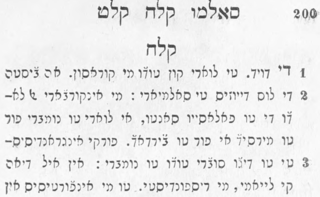Rafe
| Rafe | |
| ֿ | |
| Similar appearance | macron |
| Example | |
| פֿיש | |
| The word for fish inYiddish,fish.The first diacritic (the line over thepei) is a rafe. | |
| Other Niqqud | |
| Shva·Hiriq·Zeire·Segol·Patach·Kamatz·Holam·Dagesh·Mappiq·Shuruk·Kubutz·Rafe·Sin/Shin Dot | |

InHebreworthographytherafeorraphe(Hebrew:רָפֶה,pronounced[ʁaˈfe],meaning "weak, limp" ) is adiacritic(⟨◌ֿ⟩), a subtle horizontal overbar placed above certain letters to indicate that they are to bepronouncedasfricatives.
It originated with theTiberianMasoretesas part of the extended system ofniqqud(vowel points), and has the opposite meaning ofdageshqal,showing that one of the lettersבגדכפתis to be pronounced as africativeand not as aplosive,or (sometimes) that a consonant is single and not double; or, as the opposite to amappiq,to show that the lettersהorאare silent (mater lectionis).
The rafe generally fell out of use for Hebrew with the coming of printing, although according toGesenius(1813) at that time it could still be found in a few places in printedHebrew Bibles,where the absence of adageshor amappiqwas noticeable.[1](e.g. Exodus 20:13,14,15; Deuteronomy 5:13,17,18,19; 2 Samuel 11:1; Isaiah 22:10; Jeremiah 20:17; Psalm 119:99; Zechariah 5:11)
In somesiddurs(e.g. those printed byArtScroll) a diacritical symbol, typographically the same as the rafe, but utterly unrelated, is used to mark instances of "movingsheva"(Shva Na).[2]
The rafe is similar in function to thebuailte(dot above, denotinglenition) in the old-styleIrish Alpha bet.
Yiddish
[edit]It retained some currency inYiddishandLadino.
InYiddish orthography,the rafe distinguishesפ/p/fromפֿ/f/and in words of Semitic origin alsoב/b/fromבֿ (/v/.
| Name | Symbol | IPA | Transliteration | Example |
|---|---|---|---|---|
| Pey | פ | /p/ | p | pan |
| Fey | פֿ | /f/ | f | fan |
Ladino
[edit]
In Ladino the rafe, called avarrica( “little crossbar” ), looks more like a breve-shaped diacritic (ﬞ ) on top of the letter (◌ﬞ). When written in thesquare form,or when unable to apply the varrica rafe diacritic to a letter, it is replaced by ageresh(׳) immediately after the letter as a substitute to effect the same change in pronunciation. For example, גﬞ is equivalent to ג׳ in altering the sound from thevoiced velar stop[g] to thevoiced postalveolar affricate[d͡ʒ], known in English as "soft g".
In Ladino, as inTiberian Hebrew,the rafe changes ב [b] into בﬞ [v], ד [d] into דﬞ [ð], and פ [p] into פﬞ [f]. Unlike in Hebrew, the rafe also changes ג [g] into גﬞ ([d͡ʒ] or [t͡ʃ]), ז [z] into זﬞ [ʒ], and in words of Semitic origin also ש ([s] or [ʃ]) into שﬞ [ʃ]. In words of Romance origin, [s] is spelled as ס, freeing up ש for thevoiceless postalveolar fricative[ʃ] without the need for a rafe to disambiguate.
Note Ladino orthography is far less standardized than Yiddish; original Ladino works may be written inRashi script(using rafe), Hebrew block print (using geresh), or in theLatin Alpha bet(e.g. the 1553Ferrara Bible).
| Ladinoletters formed using a 'varrica'rafe[3] | |||||||||
|---|---|---|---|---|---|---|---|---|---|
| WithoutRafe | WithRafe(equivalent withgeresh) | ||||||||
| Symbol | Translit. | IPA | Example | Symbol | Translit. | IPA | Example | ||
| ב | b | [b] | boy | (ב׳)בﬞ | v | [v]~[β̞] | voyage | ||
| ג | g | [ɡ] | gap | (ג׳)גﬞ | dj, ǧ,orch, č | [d͡ʒ]~[t͡ʃ] | Jupiter,George,chip | ||
| ד | d | [d̪] | day | (ד׳)דﬞ | dh, th, ḏ, đ | [ð̞] | they | ||
| ז | z | [z] | zoo | (ז׳)זﬞ | j, g, zh, ž | [ʒ] | Jacques, beige, vision | ||
| ט | t | [t̪] | toy | (ט׳)טﬞ | th | [θ] | thirty | ||
| כ | c, k | [k] | care,king | (כ׳)כﬞ | ch, kh,k | [x]~[χ] | loch,Bach | ||
| פ | p | [p] | past | (פ׳)פﬞ | f | [f] | fast | ||
| ש | s, ç | [s] | sin,cent | (ש׳)שﬞ | sh, š | [ʃ] | shin | ||
Unicode
[edit]"Hebrew Point Rafe" is encoded in the Unicode standard as U+05BF.
See also
[edit]References
[edit]- ^
 Gesenius' Hebrew Grammar,§14
Gesenius' Hebrew Grammar,§14
- ^Rabbi Nosson Scherman, Rabbi Meir Zlotowitz,Siddur Kol Yaakov/The Complete ArtScroll Siddur—Nusach Ashkenaz,3rd Edition, Eighteenth Impression, Mesorah Publications Ltd., July 2003.ISBN0-89906-650-X.Preface, p. IX.
- ^"Sefarađizo: Ladino: Alefbet: Tabla".2021-09-16.Archivedfrom the original on 2021-09-16.Retrieved2021-09-16.
